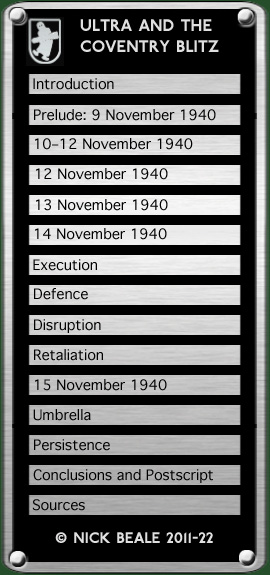|
The RAF put up 121 night fighter sorties against the raid but managed only two brief combats in which one bomber was claimed damaged. Fighters patrolled across the beams and on enemy lines of approach and were vectored on specific enemy raiders. Blenheims maintained patrols over Coventry itself at the following times (all BST): 18.57–21.14 hrs. 01.36–03.36 hrs. 01.40–03.40 hrs. from 04.40 hrs. until all hostile aircraft had gone. Clearly more had been expected, prompting an inquest the following afternoon when Fighter Command was informed that the Chief of the Air Staff: … would appreciate detailed information as to reasons for comparatively few interceptions made on night of 14/15th Nov. in spite of fine weather, moonlight and considerable effort exerted. Details of A.I. performance particularly requested. Information is required by a.m. 18th Nov. The answer came a day later and is worth reproducing for the insight it gives into the difficulties the defenders faced, even though their ranks included the world’s only radar-carrying night fighters. Of the 121 sorties: 10 Beaufighters obtained 5 A.I. blips, one of which led to a sighting. There were two unassisted sightings.
39 Blenheims obtained 6 A.I. blips but no sightings from them. Two unassisted sightings led to combat in one of which damage is claimed. 22 Defiants saw one illuminated and four unilluminated targets. 44 Hurricanes saw one unilluminated target. 4 Gladiators saw nothing. 1 Spitfire saw nothing. A factor which accounts for the better results with the Beaufighter was the more accurate raid information which was available in the Kenley Sector. The fact that only one sighting was obtained from the 11 blips in Beaufighters and Blenheims is explained by the well known poor view from these aircraft. Improvement is hoped for when the properly designed night fighting cockpit becomes available in the modified Beaufighter. The difficulty of maintaining the serviceability of the Beaufighter is well illustrated in that only ten sorties could be made out of the forty-three aircraft of this very undeveloped type which are allotted at present to service squadrons. The great majority of Blenheims were working in the areas where the plots of raids were thickest. A large number of simultaneous raids inevitably tends to congest the tubes of RDF Stations and to confuse both the Observer Corps and Searchlights, particularly those searchlights working on sound control only. The conditions, therefore, as far as Blenheims were concerned did not favour accurate plotting when working under RDF control or inland. The large number of raids also led each of the aurally controlled searchlights to expose at different raids and the lack of any indication indication of continuous track rendered the help even of cluster lights nugatory. The bright moonlight made single beams practically useless even if consistent indication of a single track had been maintained. The slightly better results obtained by Defiants may be attributed partly to the advantage which this type holds in having four eyes, a pair of which can be devoted exclusively to search, and also to better cockpits; better results, however, particularly in holding a target once seen, may be expected when the proper exhaust manifolds to remove all light interference of the exhaust flames become available. I might add that the lack of success by Hurricanes can be attributed to the same exhaust flame trouble as with the Defiant, coupled with the poor night view through the curved perspex of the windscreen. Another summary of the defensive effort partly attributed the “disappointing number of combats” to the exhaust glow from Hurricanes and Defiants, which both interfered with their pilots’ vision and alerted enemy bombers. The poor vision through the perspex screens of Blenheims and Hurricanes was also thought to have been a factor. Coventry’s 40 high-angle AA guns remained in action throughout the raid. Although the Gun Operations Room was bombed, it soon returned to action and at the end of the operation was in control of all but six of its heavy guns. The city’s 56 barrage balloons were up, along with eight of the 16 reinforcements that arrived that day. No enemy aircraft came below the level of the barrage and balloon casualties were “slight.” continued on next page …
|
||||


